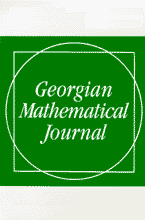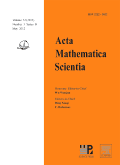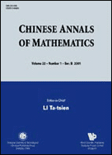
Georgian Mathematical Journal
Scope & Guideline
Elevating scholarly communication in the realm of mathematics.
Introduction
Aims and Scopes
- Functional Analysis and Operator Theory:
The journal frequently publishes research on functional analysis, including topics related to operator theory, spectral theory, and Banach spaces. This area is critical for understanding the properties and applications of linear operators. - Nonlinear Analysis:
There is a strong emphasis on nonlinear differential equations and their applications, including the study of boundary value problems, variational methods, and fixed-point theorems. - Algebra and Ring Theory:
Research in algebra, particularly on rings, algebras, and their derivations, is prominently featured. This includes studies on prime rings, Jordan algebras, and related algebraic structures. - Partial Differential Equations (PDEs):
The journal covers a wide range of topics in PDEs, focusing on both theoretical aspects and numerical solutions. This includes mixed boundary value problems, singular solutions, and stability analysis. - Geometric Analysis:
Research related to the geometry of differential equations, including minimal surfaces and geometric properties in higher-dimensional spaces, is also a key focus of the journal. - Numerical Methods and Approximations:
The journal publishes work on numerical analysis, particularly methods for solving differential equations and integral equations, highlighting both theoretical developments and practical applications.
Trending and Emerging
- Mathematical Modeling and Applications:
There is a growing trend towards mathematical modeling in various fields, including physics, engineering, and biological systems. This trend indicates a strong interest in applying mathematical theories to real-world problems. - Fractional Calculus and Differential Equations:
Research on fractional calculus and its applications in differential equations is on the rise, reflecting increased interest in non-integer order derivatives and their implications in various scientific fields. - Operator Theory and Functional Spaces:
Papers focusing on advanced operator theory and its applications in functional spaces are becoming increasingly prominent, showcasing the importance of these concepts in modern mathematical analysis. - Nonlinear Dynamics and Stability Analysis:
The journal has seen a surge in publications related to nonlinear dynamics and stability analysis, especially concerning differential equations and their applications in engineering and physical sciences. - Topological and Geometric Methods:
An increase in interest in topological methods and their applications in analysis suggests a trend towards exploring the relationships between topology and other areas of mathematics.
Declining or Waning
- Traditional Analytical Techniques:
There has been a reduction in papers focused on classical analytical techniques, such as those involving basic inequalities and traditional limit processes, as the journal shifts towards more modern and applied mathematical approaches. - Elementary Number Theory:
Research in elementary number theory, once a staple in mathematical journals, has decreased in this journal. This might reflect a broader trend in mathematical research moving towards more abstract and complex structures. - Statistical Methods in Pure Mathematics:
The journal has seen fewer papers focusing on purely statistical methods or foundational statistical theories, indicating a shift towards more applied statistical methodologies integrated with other mathematical disciplines.
Similar Journals

Bulletin of the Karaganda University-Mathematics
Pioneering Research in Theoretical and Applied MathematicsBulletin of the Karaganda University-Mathematics is a distinguished journal dedicated to the exploration and dissemination of research in the field of mathematics. Published by KARAGANDA STATE UNIVERSITY in Kazakhstan, this Open Access journal has been promoting the accessibility of scientific knowledge since 2010. With an ISSN of 2518-7929, the journal aims to provide a platform for innovative ideas and developments across various mathematical disciplines. Recognized for its quality, it has achieved a Q3 ranking in the Mathematics (miscellaneous) category for 2023 and is currently positioned at the 46th percentile within Scopus rankings, demonstrating its relevance and contribution to the academic community. The bulletin encourages submissions that enrich theoretical and applied mathematics and is an essential resource for researchers, professionals, and students looking to enhance their understanding and application of mathematical concepts. Addressed from 38 GOGOL STR, KARAGANDA 100012, KAZAKHSTAN, the journal not only represents the academic excellence of its home institution but also aims to foster international collaboration and knowledge exchange.

ACTA MATHEMATICA SCIENTIA
Innovating Research at the Intersection of Math and PhysicsACTA MATHEMATICA SCIENTIA is a reputable academic journal published by Springer, primarily focusing on the interdisciplinary fields of mathematics and physics. With an ISSN of 0252-9602 and an E-ISSN of 1572-9087, the journal has established itself as an influential platform for researchers and professionals seeking to disseminate novel findings in these domains. Based in the Netherlands, the journal holds a commendable Q2 category ranking in both Mathematics and Physics & Astronomy for 2023, reflecting its significance in the academic community. With a focus extending from 1996 to 2024, ACTA MATHEMATICA SCIENTIA serves as a vital resource for scholars, offering insights that bridge theoretical and applied sciences. Published under rigorous peer review, the journal fosters a robust scholarly dialogue and encourages innovative research that challenges existing paradigms. While access is not open, the journal's contributions are of paramount importance for advancing knowledge in the mathematical sciences and their applications in physical contexts.

Ufa Mathematical Journal
Advancing Mathematical Frontiers with Rigorous ResearchUfa Mathematical Journal, published by the Institute of Mathematics and Computer Center in Russia, is an esteemed platform dedicated to the dissemination of high-quality research in the field of mathematics. With its ISSN 2074-1863 and E-ISSN 2074-1871, the journal serves as a vital resource for mathematicians, researchers, and academicians seeking to explore innovative methodologies and findings in various mathematical domains. Although presently operating under a subscription model, the journal’s commitment to advancing mathematical knowledge is underscored by its rigorous peer-review process and its aim to contribute significantly to the global mathematical community. With a focus on original research articles, the Ufa Mathematical Journal plays an essential role in fostering scholarly dialogue and collaboration among professionals in the field.

CUBO-A Mathematical Journal
Advancing Knowledge Across Mathematical DisciplinesCUBO-A Mathematical Journal, published by the Department of Mathematics and Statistics at Universidad de La Frontera in Chile, stands as a significant Open Access resource in the field of mathematics since its inception in 2011. With an ISSN of 0716-7776 and an E-ISSN of 0719-0646, this journal invites submissions that explore a wide spectrum of mathematical disciplines, including Algebra, Number Theory, Analysis, Geometry, Topology, and Logic. Although currently positioned in the Q4 category across various mathematical domains and registered at Rank #223/399 in General Mathematics in Scopus, CUBO serves as a valuable platform for emerging researchers and practitioners to disseminate their findings. Operating under a continuous commitment to accessibility, CUBO fosters an inclusive academic environment that supports the exchange of innovative ideas vital to advancing mathematics. The journal's target audience encompasses a diverse community of researchers, professionals, and students eager to participate in the expanding dialogue within mathematical sciences.

Applied Mathematics E-Notes
Empowering the Future of Mathematics through CollaborationApplied Mathematics E-Notes, a prominent publication within the field of Applied Mathematics, is produced by the Department of Mathematics at Tsing Hua University in Taiwan. With its inception in 2001, the journal continues to serve as a vital resource for disseminating research findings, methodologies, and applications that advance the understanding of mathematical theories and their practical implications. Though currently categorized in Q4 within its field, the journal remains dedicated to fostering innovation and collaborative research, reflecting its growth potential in the coming years. The journal is accessible online, catering to a global audience of researchers, professionals, and students seeking to enrich their knowledge and engage with contemporary topics in applied mathematics. Through its commitment to open dialogue in mathematical sciences, Applied Mathematics E-Notes plays an essential role in bridging theoretical research with real-world applications.

RENDICONTI DEL SEMINARIO MATEMATICO DELLA UNIVERSITA DI PADOVA
Connecting mathematicians through accessible, impactful research.RENDICONTI DEL SEMINARIO MATEMATICO DELLA UNIVERSITA DI PADOVA, published by the European Mathematical Society, stands as a notable open-access journal with a rich history in disseminating research across various domains of mathematics. With an ISSN of 0041-8994 and E-ISSN 2240-2926, this journal has embraced open access since 2023, significantly enhancing its visibility and accessibility to a global audience. Situated in Germany, its publishing house is based at Technical University Berlin, which emphasizes its academic roots and dedication to fostering mathematical research. The journal features a quartile ranking of Q3 across multiple categories including Algebra and Number Theory, Analysis, Geometry and Topology, and Mathematical Physics as of 2023, indicating a vibrant contribution to the field, despite its challenge in specific rankings. Researchers, professionals, and students alike will find in this journal a platform for innovative ideas and significant findings that are crucial to the evolution of modern mathematics.

Matematicki Vesnik
Fostering excellence in mathematical inquiry since 1993.Matematicki Vesnik is a distinguished open-access journal published by the MATH SOC SERBIA-DRUSTVO MATEMATICARA SRBIJE, dedicated to advancing the field of mathematics since its inception. With an ISSN of 0025-5165 and an E-ISSN of 2406-0682, this journal has been a significant platform for disseminating research findings since its establishment in 1993. Hosted in Serbia, it embraces a broad scope of mathematical discourse while achieving a Q3 category ranking in miscellaneous mathematics for 2023. As part of its commitment to fostering scholarly communication, Matematicki Vesnik is accessible to a global audience, promoting high-quality research and innovative ideas within the mathematical community. With converged years from 1999 to 2024 and a Scopus rank of #232 out of 399 in General Mathematics, the journal plays a crucial role in enhancing visibility and impact for researchers, professionals, and students alike in the dynamic landscape of mathematical inquiry.

CHINESE ANNALS OF MATHEMATICS SERIES B
Connecting Tradition and Innovation in Mathematical ScholarshipCHINESE ANNALS OF MATHEMATICS SERIES B, published by Shanghai Scientific Technology Literature Publishing House, is a prominent journal dedicated to fostering research and development in the field of mathematics. With an ISSN of 0252-9599 and an E-ISSN of 1860-6261, this journal provides a platform for the dissemination of innovative mathematical theories and methodologies. As of 2023, it is categorized within the Q4 quartile in *Applied Mathematics* and has achieved a commendable Q3 rank in *Mathematics (miscellaneous)*, emphasizing its growing influence in academia. Despite not being an open-access publication, it serves as a valuable resource for researchers, professionals, and students seeking to explore diverse mathematical topics, particularly from a unique regional perspective. The journal's extensive publication history—from 1980 and continuing to 2024—demonstrates a longstanding commitment to advancing mathematical knowledge and providing insights into various disciplines related to mathematics.

NONLINEAR ANALYSIS-THEORY METHODS & APPLICATIONS
Connecting Theory with Practice in Nonlinear DynamicsNONLINEAR ANALYSIS-THEORY METHODS & APPLICATIONS, published by PERGAMON-ELSEVIER SCIENCE LTD in the United Kingdom, is a premier journal that has been advancing the field of nonlinear analysis since its inception in 1976. This esteemed journal has a commendable impact factor, reflecting its crucial role in disseminating high-quality research in Analysis and Applied Mathematics, having achieved Q1 rankings in both categories for 2023. With an impressive Scopus ranking of #36 out of 193 in Mathematics-Analysis and #194 out of 635 in Mathematics-Applied Mathematics, it provides a platform for groundbreaking studies that push the boundaries of theoretical and applied methodologies. Although it operates through a subscription model, the journal’s comprehensive content serves as an invaluable resource for researchers, professionals, and students alike, contributing to the ongoing dialogue in the field and fostering advancements in technology and science.

Proceedings of the Institute of Mathematics and Mechanics
Bridging Communities through Innovative Mathematical ResearchProceedings of the Institute of Mathematics and Mechanics is a pivotal journal in the field of mathematics, dedicated to the advancement and dissemination of cutting-edge research in various sub-disciplines. Published by INST MATHEMATICS & MECHANICS, NATL ACAD SCIENCES AZERBAIJAN, this journal plays a significant role in bridging local and international research communities. With an ISSN of 2409-4986 and E-ISSN of 2409-4994, it has gained recognition, attaining a Q3 ranking in the Miscellaneous Mathematics category and placing in the 67th percentile on Scopus. Run from 2017 to 2024, the journal serves as an accessible platform for scholars and practitioners, inviting contributions that advance theoretical knowledge and practical applications in mathematics. With an emphasis on quality and innovation, the Proceedings of the Institute of Mathematics and Mechanics stands out as a vital resource for those looking to stay at the forefront of mathematical research and its multifaceted applications in various fields.